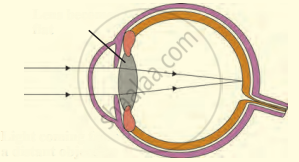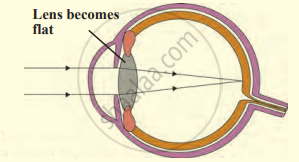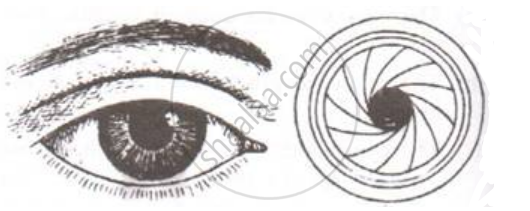Advertisements
Advertisements
Question
The following figure show the change in the shape of the lens while seeing distant and nearby objects. Complete the figures by correctly labelling the diagram.

Solution
Light coming from a distant object-

APPEARS IN
RELATED QUESTIONS
The optical prescription for a pair of spectacles is :
Right eye : −3.50 D
Left eye : −4.00 D
Which lens has a greater focal length?
Out of rods and cones m the retina of your eye:
which detect colour?
What is the least distance of distinct vision for a normal human eye?
Fill in the following blank with suitable words:
When light is dim, the pupil becomes................
What changes take place in the shape of eye-lens:
when the eye is focused on a near object?
There are two types of light-sensitive cells in the human eye:
Where are they found?
To focus the image of a nearby object on the retina of an eye:
(a) the distance between eye-lens and retina is increased
(b) the distance between eye-lens and retina is decreased
(c) the thickness of eye-lens is decreased
(d) the thickness of eye-lens is increased
Suggest how your irises help to protect the retinas of your eyes from damage by bright light.
What are the advantages of having two eyes instead of just one?
With both eyes open, a person's field of view is about:
(a) 90°
(b) 150°
(c) 180°
(d) 360°
We see advertisements for eye donation on television or in newspapers. Write the importance of such advertisements.
Give scientific reason:
One can sense colours only in bright light.
Select the odd one in the following series:
Retina, Sclera, Ciliary body, Nephron.
Name the respective organs in which the following are located and mention the main function of each:
(i) Iris
(ii) Semicircular canals
Give the main function of the following:
Lachrymal glands
The figure below compares a part of our eye with a part of a photographic camera.

Explain the mode of working and the functions of the parts of the eye mentioned above.
What happens to the image distance in the normal human eye when we decrease the distance of an object, say 10 m to 1 m? Justify your answer.
What is meant by power of accommodation of the eye?
Draw a diagram of the human eye as seen in a vertical section and label the parts which suit the following descriptions relating to the:
(i) photosensitive layer of the eye.
(ii) structure which is responsible for holding the eye lens in its position.
(iii) structure which maintains the shape of the eyeball and the area of no vision.
(iv) anterior chamber seen in front of the eye lens.
(v) outermost transparent layer seen in front of the eyeball.
Name the following:
The focal length of the lens is altered by the contraction of which type of muscles.
What is the nature of the image that forms on the retina?
Mention, if the following statement is True or False
The least distance of distinct vision for the human eye is 25 cm
Choose the Odd One Out:
For the normal human eye, the near point is at ___________ cm.
Vision defect that increases distance between the lens of the eye and retina of the eye is termed as myopia.
The black opening between the aqueous humour and the lens is called ____________.
At noon the sun appears white as
From where the following nerves arise.
Optic nerve
What kind of lens is there in our eyes? Where does it form the image of an object?
The transparent membrane that keeps the eye moist is ______.
What is ‘white of the eye’?
In human eye the part which allows light to enter into the eye is ______.
Match the following:
| Column - I | Column - II |
| 1. Retina | a. Path way of light |
| 2. Pupil | b. Far point comes closer |
| 3. Ciliary muscles | c. near point moves away |
| 4. Myopia | d. Screen of the eye |
| 5. Hypermetropia | e. Power of accommodation |
State the functions of the following:
Ciliary muscles
Name the following:
The circular opening enclosed by iris.
Name the following:
Capacity of the eye to focus at different distances.
Name the following:
The layer of the wall of the eye-ball that corresponds to the black lining of the box of a camera
An aperture that controls the passage of light into the eye is ______.
Write the main functional activity of the following structure.
Ciliary body and suspensory ligament
Differentiate between members of the following pair with reference to what is asked in the bracket.
Aqueous humour and vitreous humour (location).
